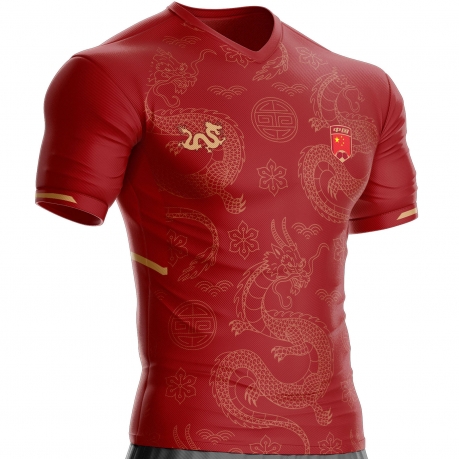Top 10 most expensive Chinese player transfers

Changing Chinese football: an ambitious strategy
Chinese football has undergone a dramatic transformation in recent years. Once considered a fringe sport, it is now booming, attracting the attention of investors and talents around the world. This development has notably resulted in a growing interest in foreign players, whose transfers reach astronomical sums.
The Chinese championship, the Chinese Super League (CSL), has become a real magnet for international stars. Renowned players such as Carlos Tevez, Oscar and Hulk have been attracted to lucrative contracts, helping to raise the level of play and visibility of Chinese football.
Among the most notable transfers, we can cite the arrival of Oscar from Chelsea FC in 2017 for a record fee of 60 million euros. This transaction symbolized the boundless ambition of Chinese clubs and their desire to climb among the best in the world.
The influx of foreign players has had a huge impact on Chinese football. The level of play has improved significantly, attracting a wider audience and generating growing enthusiasm for the sport. The CSL is now one of the most popular leagues in Asia, and its clubs compete with the most prestigious teams on the continent.
However, this ambitious strategy is not without its critics. Some observers question the viability of a system based on expensive transfers and exorbitant salaries. Others fear that the development of Chinese football will come at the expense of local players and the training of young talents.
Despite these criticisms, it is undeniable that Chinese football is changing. The arrival of foreign players has contributed to the professionalization of the championship and its international development. Time will tell whether this ambitious strategy will allow Chinese football to realize its dreams of grandeur and compete with the best nations in the world.
The 5 most expensive transfers: An overview of Chinese ambitions
1. Oscar (Chelsea FC to Shanghai SIPG, 2017) – 60 million euros
This record transfer marked a turning point in the history of Chinese football. The arrival of a player of Oscar's caliber symbolized the ambition of Chinese clubs to compete with the biggest teams in Europe. His talent and popularity helped raise the CSL's profile and attract other international stars.
2. Hulk (Zenit Saint Petersburg to Shanghai SIPG, 2016) - 55.8 million euros
The arrival of Hulk, a powerful Brazilian striker, reinforced the attractiveness of the CSL and its status as an attractive destination for renowned players. His impact on the pitch was immediate, contributing to Shanghai SIPG's success and improving the league's standard of play.
3. Alex Teixeira (Shakhtar Donetsk to Jiangsu Suning, 2016) – 50 million euros
This transfer confirmed the financial attractiveness of the CSL and its ability to attract talented players playing in renowned European championships. Teixeira quickly established himself as one of the best players in the league, thanks to his technical qualities and creativity.
4. Jackson Martínez (Atlético Madrid to Guangzhou Evergrande, 2016) – 42 million euros
The arrival of Jackson Martínez, an experienced Colombian striker, brought an extra dimension to Guangzhou Evergrande's attack. His experience and efficiency allowed the club to dominate the CSL and win several consecutive titles.
5. Ramires (Chelsea FC to Jiangsu Suning, 2016) – 28 million euros
The transfer of Ramires, a combative and versatile midfielder, is part of the strategy of Chinese clubs to strengthen their squad with experienced and seasoned players at the highest level. His contribution was valuable for Jiangsu Suning, which established itself as one of the most ambitious clubs in the CSL.
Analysis of motivations
Behind these expensive transfers lie several motivations:
Sporting ambition : Chinese clubs aspire to compete with the best clubs in the world and win continental titles. The arrival of talented foreign players is considered an essential element in achieving this objective.
Development of the Chinese championship : By attracting international stars, the CSL seeks to increase its popularity and attractiveness among sponsors and broadcasters. Improving the level of play is also a major objective to establish the credibility of Chinese football on the international scene.
Enhancement of China's image : The development of football is also seen as a means of enhancing China's image abroad and demonstrating its economic power and growing influence.
Impact on the Chinese and international football landscape
The arrival of foreign players has had a considerable impact on Chinese football:
Improved level of play : The CSL has become a more competitive and attractive league, with a more fluid and spectacular style of play.
Increase in popularity : Football attracts a wider audience in China, with television audiences steadily increasing.
Infrastructure Development : Chinese clubs are investing heavily in building modern stadiums and state-of-the-art training centers.
Increased attractiveness for foreign players : The CSL is attracting more and more talented players from Europe and South America.
The influence of Chinese football is also felt on the international stage:
Investments in foreign clubs : Chinese clubs buy foreign clubs, such as AC Milan in Italy, and invest in their development.
Hosting international competitions : China hosted the FIFA Club World Cup in 2021 and aims to host the FIFA World Cup in the future.
Foreign player transfers have played a crucial role in the transformation of Chinese football. The ambition of Chinese clubs, combined with the financial power of its investors, has enabled the CSL to become one of the most attractive championships in Asia. However, questions remain about the long-term viability of this model and its impact on the development of young Chinese talents.
Other important transfers that marked Chinese football
1. Carlos Tevez (Juventus to Shanghai Shenhua, 2016) – 38 million euros
The arrival of Carlos Tevez, a charismatic and talented Argentine striker, marked a turning point in the attractiveness of the CSL for renowned players. His worldwide popularity and his footballing qualities have contributed to the media coverage of the Chinese championship and the increase in its international audience.
2. Ezequiel Lavezzi (Paris Saint-Germain to Hebei China Fortune, 2016) – 32 million euros
The experience and technique of Lavezzi, an Argentine striker, brought added value to Hebei China Fortune's attack. His rapid adaptation to Chinese football and his involvement in the development of the club have made him a real asset for the CSL.
3. Paulinho (Tottenham Hotspur to Guangzhou Evergrande, 2015) – 32 million euros
The transfer of Paulinho, a powerful and versatile midfielder, marked the beginning of the expansion of Chinese football abroad. His success in China allowed him to return to the Brazilian national team and sign a lucrative contract with FC Barcelona.
4. Marouane Fellaini (Manchester United to Shandong Luneng Taishan, 2019) – 17.5 million euros
The arrival of Fellaini, an experienced and combative midfielder, strengthened the physical aspect of Shandong Luneng Taishan's game. His presence also helped improve the leadership and mentality of the team.
5. Yannick Carrasco (Atlético Madrid to Dalian Yifang, 2018) – 30 million euros
The talent and speed of Carrasco, a Belgian winger, brought an additional offensive dimension to Dalian Yifang. His quick adaptation to Chinese football and active participation in the game made him an important part of the team.
Analysis of the implications
These important transfers had several implications for the development of Chinese football:
Diversification of profiles : The arrival of players from different nationalities and cultures has made it possible to enrich the CSL's style of play and provide tactical variety.
Skills transfer : Foreign players contribute to the training of Chinese players by sharing their experience and know-how.
Promotion of Chinese football : The presence of international stars attracts the attention of foreign media and contributes to the promotion of Chinese football internationally.
Foreign player transfers have played a crucial role in the rise of Chinese football. They helped improve the level of play, increase the popularity of the championship and promote Chinese football internationally.
Assessment and prospects of Chinese football
Assessment of the effects of transfers of foreign players
Foreign player transfers have had a positive impact on Chinese football:
Improved level of play : The CSL has become a more competitive and attractive league, with a more fluid and spectacular style of play.
Increase in popularity : Football attracts a wider audience in China, with television audiences steadily increasing.
Infrastructure Development : Chinese clubs are investing heavily in building modern stadiums and state-of-the-art training centers.
Increased attractiveness for foreign players : The CSL is attracting more and more talented players from Europe and South America.
Challenges and opportunities
Challenges :
High cost of transfers : The soaring prices of foreign players can weaken the financial situation of Chinese clubs.
Impact on the development of local players : The risk is to see Chinese players relegated to the background by international stars.
Lack of depth : The level of play outside the richest clubs often remains mediocre.
Opportunities :
Professionalization of Chinese football : Transfers of foreign players contribute to the professionalization of Chinese football and the improvement of club management standards.
Development of young talents : The presence of foreign players can serve as a role model for young Chinese players and inspire them to improve.
Promotion of Chinese football internationally : The success of Chinese clubs on the international stage can contribute to the promotion of Chinese football on a global scale.
Future prospects
Chinese football has strong development potential. The ambitions of Chinese clubs and the significant investments made in this area bode well for a promising future.
However , for Chinese football to truly compete with the best nations in the world, it is important to address the challenges related to the management of foreign player transfers and to implement a sustainable development strategy that relies on training. young Chinese talents.
Foreign player transfers have played an important role in the transformation of Chinese football. They helped improve the level of play, increase the popularity of the championship and promote Chinese football internationally.
The future of Chinese football will depend on the ability of Chinese clubs to meet the challenges linked to this trend and to implement a sustainable development strategy that relies on the training of young Chinese talents.
Summary of key points from the article :
Chinese football has seen spectacular growth in recent years thanks to the influx of foreign players.
Expensive transfers of renowned players have helped to improve the level of play in the CSL and increase its popularity.
This ambitious strategy is not without challenges, including the high cost of transfers and the impact on the development of local players.
The future of Chinese football will depend on its ability to meet these challenges and implement a sustainable development strategy.
Reflections on the future of Chinese player transfers and their impact on world football :
The trend of Chinese player transfers to the CSL is likely to continue in the coming years.
This trend will have an impact on world football by contributing to the redistribution of talent and the diversification of championships.
The success of Chinese clubs on the international stage could encourage other countries to adopt a similar strategy.
In conclusion, Chinese player transfers constitute an important phenomenon that will have a lasting impact on Chinese football and world football.






